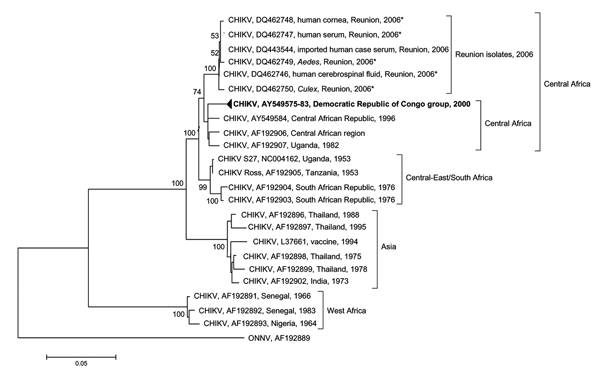Chikungunya Virus Strains, Reunion Island Outbreak
Maël Bessaud*, Christophe N. Peyrefitte*†, Boris A.M. Pastorino*, Fabienne Tock*, Olivier Merle*, Jean-Jacques Colpart‡, Jean-Sébastien Dehecq§, Romain Girod*, Marie-Christine Jaffar-Bandjee¶, Pamela J. Glass#, Michael Parker#, Hugues J. Tolou*, and Marc Grandadam*

Author affiliations: *Institut de médecine tropicale du Service de santé des armées, Marseille, France; †Walter Reed Army Institute of Research, Silver Spring, Maryland, USA; ‡Agence de la biomédecine, Lyon, France; §Direction régionale des affaires sanitaires et sociales, Saint-Denis, Île de la Réunion, France; ¶Centre hospitalier départemental Félix-Guyon, Saint-Denis, Île de la Réunion, France; #United States Army Medical Research Institute for Infectious Diseases, Fort Detrick, Maryland, USA
Main Article
Figure

Figure. Phylogenetic tree of chikungunya virus (CHIKV) based on partial nucleotide sequences (3´ extremity of E1/3´ untranslated, position 10238–11367). Phylogram was constructed with MEGA 2 (http://megasoftware.net/mega2.html), and the tree was drawn with the Jukes-Cantor algorithm for genetic distance determination and the neighbor-joining method. The percentage of successful bootstrap replicates (1,000 bootstrap replications, confidence probability >90%) is indicated at nodes. The length of branches is proportional to the number of nucleotide changes (percentage of divergence). Asterisks (*) indicate strains isolated in this study. The dark triangle corresponds to viruses of the Democratic Republic of Congo clustering together (GenBank accession nos. AY549575–AY549583). O'nyong-nyong virus (ONNV) sequence has been introduced for correct rooting of the tree.
Main Article
Page created: November 10, 2011
Page updated: November 10, 2011
Page reviewed: November 10, 2011
The conclusions, findings, and opinions expressed by authors contributing to this journal do not necessarily reflect the official position of the U.S. Department of Health and Human Services, the Public Health Service, the Centers for Disease Control and Prevention, or the authors' affiliated institutions. Use of trade names is for identification only and does not imply endorsement by any of the groups named above.
